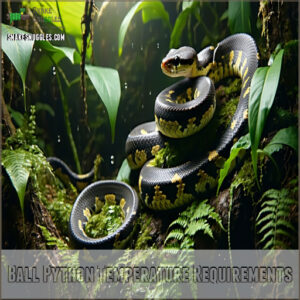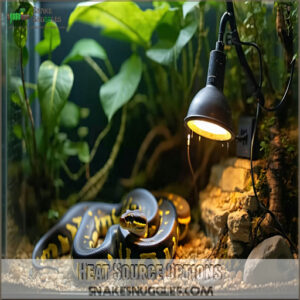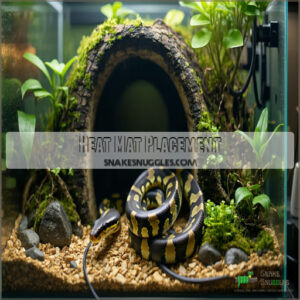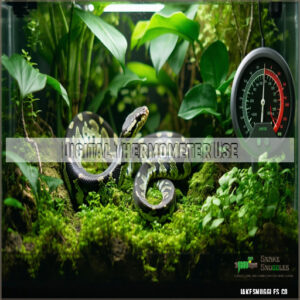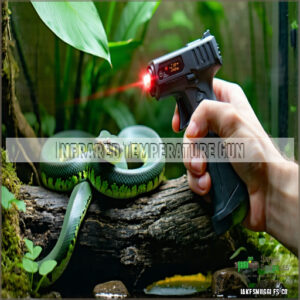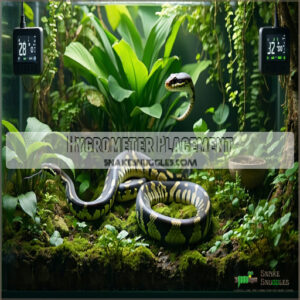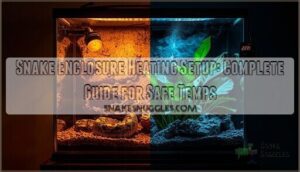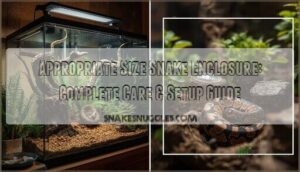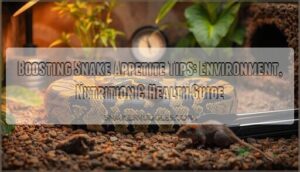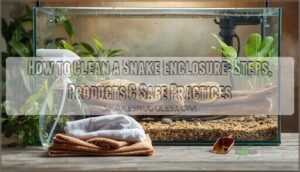This site is supported by our readers. We may earn a commission, at no cost to you, if you purchase through links.
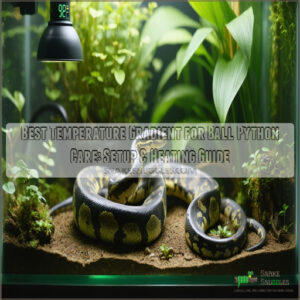 Your ball python’s comfort zone isn’t one-size-fits-all – it’s all about creating temperature zones that let your snake be its own thermostat!
Your ball python’s comfort zone isn’t one-size-fits-all – it’s all about creating temperature zones that let your snake be its own thermostat!
You’ll want to set up a cozy gradient with a basking spot of 90-95°F, a warm hide around 86-90°F, and a cool retreat at 75-80°F.
Think of it like your snake’s personal climate control system: they’ll move between zones to regulate their body temperature, just like they would in their African homeland.
At night, keep the ambient temperature between 70-78°F, which is the secret to a happy, healthy python, by getting these temperatures just right.
Table Of Contents
- Key Takeaways
- Ball Python Temperature Requirements
- Creating Temperature Gradient
- Ideal Humidity Levels
- Measuring Temperature Accurately
- Maintaining Optimal Environment
- Frequently Asked Questions (FAQs)
- What temp should the floor be for a ball python?
- Is 100 degrees to hot for ball python?
- Can you leave a heat lamp on 24/7 for ball python?
- Is 78 too cold for a ball python?
- Can temperature fluctuations impact feeding response patterns?
- What signs indicate a python is too hot?
- Should temperature gradient change during breeding season?
- Conclusion
Key Takeaways
- You’ll need a basking spot of 90-95°F, a warm hide around 86-90°F, and a cool retreat at 75-80°F to create an effective temperature gradient that lets your ball python thermoregulate naturally.
- Your nighttime temperatures should drop to 70-78°F to mimic natural conditions, but never let them fall below 70°F to prevent health issues.
- You’ll want to use multiple temperature monitoring tools – a digital thermometer for ambient air readings and an infrared temperature gun for checking surface temperatures at snake level.
- Your heat source needs to connect to a thermostat for safety, whether you’re using heat lamps, ceramic heaters, or heat mats, to prevent dangerous temperature spikes above 95°F.
Ball Python Temperature Requirements
Keeping your ball python at the right temperature is critical for their health and happiness.
With a proper gradient that mimics their natural habitat, your snake can thermoregulate, digest, and stay active comfortably.
Basking Surface Temperature
Getting the basking surface temperature right is essential for your ball python. Aim for 90-95°F to create the ideal hot spot. Use an infrared temperature gun for accuracy.
Maintaining proper ball python humidity levels is also important for their health and well-being.
Popular heat sources include:
- Heat lamps for natural brightness and warmth.
- Ceramic heaters for non-light heat.
- Slate or flat rocks as basking spots.
A proper heat gradient keeps your snake cozy and healthy, ensuring the right environment for your ball python with a suitable hot spot.
Warm Hide Temperature
While your ball python needs a cozy retreat, maintaining the warm hide temperature between 86-90°F is important for proper digestion and comfort.
For ideal basking and digestion, maintain proper warm side temperatures.
Your snake’s den heating shouldn’t exceed 95°F, as this can be dangerous. Set up the hide box temperature using a thermostat-controlled heat mat or lamp, and you’ll create the perfect thermal gradient for your scaly friend’s warm hideaway.
Cool Hide Temperature
While your warm hide keeps your snake cozy, you’ll want to set up a cool hide between 72-80°F.
Think of it as your python’s personal chill-out zone!
A properly placed cool hide helps your snake regulate its body temperature naturally, just like they do in the wild.
Maintaining proper ball python temperature requirements is essential for their health and well-being.
- Place digital thermometers at snake level to monitor cool spots accurately
- Position the cool hide on the opposite end from heat sources
- Maintain temperatures above 75°F to prevent health issues
- Use substrate that retains heat without getting too warm
- Check hide box temperatures twice daily with an infrared gun
Nighttime Temperature
After your snake settles into its cool hide, you’ll want to manage those nighttime temperature drops.
Your ball python needs temperatures between 70-78°F during low light hours, mimicking natural thermal cycles.
Don’t worry if you notice slight temperature fluctuations – that’s perfectly normal!
Just make sure your cooling methods keep the ambient temperature above 70°F to maintain a safe, comfortable environment for your scaly friend.
Creating Temperature Gradient
You’ll need to set up your ball python’s enclosure with both warm and cool areas, just like giving them their own climate-controlled apartment with different temperature zones.
Creating this temperature range from 88-95°F on the warm side to 75-80°F on the cool side lets your snake move around to find their perfect comfy spot, just like how we humans adjust our thermostats.
Heat Source Options
For effective heating, you’ll need a combination of reliable heat sources.
Heat lamps offer simple, budget-friendly warmth, while ceramic heaters provide consistent heat without light.
You can find suitable ball python heat lamps online.
You can also use heat mats or radiant panels, but they’re most effective when paired with overhead heating.
Whatever you choose, always connect it to a thermostat – it’s like having a safety net for your ball python’s temperature gradient.
Heat Mat Placement
Now that you’ve selected your heat source, let’s talk about heat mat positioning. While heat mats aren’t ideal as primary heaters for ball pythons, they work great as backup warmth generators.
Place them either under the substrate or on top of a black box hide with a flagstone piece above.
For safety’s sake, never let your snake directly contact the mat – that’s a recipe for burns!
Thermostat Use
For reliable temperature control, you’ll need a quality thermostat connected to your heat source. It’s like having a personal temperature guardian for your ball python!
Proper snake enclosure temperature control is essential for their well-being.
Your thermostat setup should include:
- A digital probe placed at your snake’s level
- Clear display readings for quick temperature checks
- Automatic shut-off if temperatures exceed safe limits.
Don’t skip this essential equipment – it prevents overheating and keeps your python cozy and safe with proper temperature control.
Ideal Humidity Levels
You’ll want to keep your ball python’s humidity between 40-60% during regular times and bump it up to 65-70% when they’re shedding, just like giving them a spa day for their skin.
To maintain these levels, you’ll need a good digital hygrometer and some basic tools like a spray bottle, water bowl, and moisture-retaining substrate, which work together like a mini rainforest in your snake’s home.
Daytime Humidity
Maintaining proper humidity control during daylight hours keeps your ball python comfortable and healthy.
You’ll want to keep moisture levels between 60-80% through a combination of water evaporation and strategic misting.
Your ball python’s temperature gradient works hand-in-hand with humidity – warm air holds more moisture, so placing water bowls near heat sources helps maintain ideal humidity levels naturally.
Nighttime Humidity
Your ball python’s nighttime humidity needs mirror their natural habitat, where levels soar to 80-100%.
Maintaining ideal temperature and humidity is essential for a ball python’s health and well-being.
You’ll want to boost humidity through water evaporation and a humid hide as the sun sets.
A light misting before bedtime helps maintain these levels, while fogging systems can automate the process.
Just remember, proper humidity control lets your snake rest comfortably, just like they’d in the wild, with ideal temperature and humidity levels.
Humidity Adjustment
Now that you’ve got your nighttime moisture dialed in, let’s talk about adjusting humidity throughout the day.
You’ll want to mist your python’s enclosure with warm water when humidity levels drop below 50%.
Keep an eye on those evaporation rates – they’ll tell you when to spritz again.
A humid hide filled with damp sphagnum moss works wonders for moisture retention, especially during shedding time.
Measuring Temperature Accurately
You’ll need more than those old-school stick-on thermometers to keep your ball python comfortable, just like you wouldn’t trust a mood ring to check your temperature when you’re sick.
Getting accurate temperature readings is a breeze when you use the right tools: a digital thermometer for checking the air temperature and an infrared temperature gun for measuring those basking spots.
Digital Thermometer Use
Now that you’ve got your humidity sorted, let’s talk about your digital thermometer – your best friend for accurate temperature readings.
You’ll want to check those digital displays daily to guarantee your snake’s comfort. Finding the right digital thermometer for reptiles is essential for proper husbandry.
Here’s what makes digital thermometers your go-to tool:
- They’re way more accurate than those stick-on analog thermometers from pet stores
- Most models include dual probes for monitoring both warm and cool sides
- Many come with temperature alerts if things get too hot or cold
- Digital displays make quick temperature checks a breeze
- They’re perfect for tracking your ball python’s temperature gradient over time
Remember to place your temperature probes at snake level for the most accurate readings. Your digital thermometer’s sensor accuracy depends on proper calibration and strategic probe placement throughout the enclosure.
Infrared Temperature Gun
While digital thermometers give you the basics, an infrared temperature gun lets you play "temperature detective" with pinpoint accuracy.
You can find a variety of infrared temperature gun products to help you in this task.
You’ll measure surface temps instantly by pointing and clicking – perfect for checking your ball python’s basking spots.
For best results, hold the gun 6 inches from the surface, and always calibrate it first.
It’s like having x-ray vision into your snake’s thermal world!
Hygrometer Placement
While your infrared gun helps track surface heat, proper hygrometer placement is your key to nailing those perfect humidity levels for your ball python.
You’ll want to position humidity sensors strategically throughout the enclosure.
- Place your main hygrometer at mid-height, away from water bowls and humid hides
- Install a second sensor near the basking area for accurate moisture readings
- Position a third probe in the cool zone for complete coverage
Maintaining Optimal Environment
You’ll need to keep your ball python’s home just right, like setting up a cozy beach resort with both sunny and shady spots that range from 75°F to 95°F.
Your snake’s comfort depends on creating distinct temperature zones, so you’ll want to set up the warm basking area at one end and the cooler retreat at the other, just like nature intended.
Thermal Gradient Zones
Once you’ve got your temperature tools set up, understanding thermal gradient zones will make your ball python’s life so much better.
Your enclosure should create distinct temperature zones, like a cozy temperature gradient from warm to cool.
The warm side needs to stay around 88-92°F, while the ambient levels should hover near 82°F.
Your cool side? Keep it comfy at 75-80°F for perfect heat distribution.
Hiding Spot Temperatures
When setting up your ball python’s thermal hides, you’ll need two distinct temperature zones to keep your scaly friend happy and healthy. Corn snakes require specific temperature gradient parameters.
Your warm hide temperature should stay between 86-90°F, while the cool hide temperature needs to keep 72-80°F.
- Place digital thermometers inside each hide for accurate readings
- Position the warm hide directly above the heat source
- Keep the cool hide on the opposite end of the enclosure
- Monitor hide temperatures daily to confirm proper ball python temperature gradient.
To ensure the health and happiness of your pet, it is crucial to follow these guidelines carefully, focusing on creating the right temperature zones and maintaining a suitable environment, which includes a thermal hide setup that meets the specific needs of your scaly friend.
Water Bowl Placement
The right water bowl placement is critical for your ball python’s temperature gradient.
Position a heavy ceramic bowl on the cooler side of the enclosure, where it’ll contribute to humidity through natural evaporation rates without disrupting the thermal gradient.
You’ll want a bowl that’s large enough for occasional soaking but not so deep that it risks drowning – about 2-3 inches is perfect, allowing for a safe and healthy environment for your ball python, with a suitable humidity level.
Substrate Choice
When setting up your ball python’s home, choose a substrate that maintains the right temperature gradient while holding moisture.
For effective humidity control, use a thick layer (2-4 inches) of tropical soil or a soil-sand blend. This bedding material helps regulate ball python substrate temperature and creates a natural environment.
For bioactive setups, you’ll find natural soil types work best, keeping those perfect temperature ranges stable.
Frequently Asked Questions (FAQs)
What temp should the floor be for a ball python?
You’ll want your ball python’s floor temperature around 78-80°F on the cool side and 86-90°F on the warm side.
Don’t let it exceed 95°F, or you’ll have one unhappy snake!
Is 100 degrees to hot for ball python?
You wouldn’t want to cook your noodle, would you?
A temperature of 100 degrees is too hot for your ball python.
Keep the basking spot between 88-95°F to guarantee your snake’s comfort and safety.
Can you leave a heat lamp on 24/7 for ball python?
You shouldn’t keep your heat lamp on constantly.
Instead, turn it off at night to create natural temperature drops that’ll help your ball python stay healthy – just like they’d experience in the wild.
Is 78 too cold for a ball python?
Wondering if your ball python’s feeling a bit chilly?
While 78°F isn’t dangerous, it’s at the low end of their comfort zone.
You’ll want the ambient temperature around 80-82°F for ideal health and activity.
Can temperature fluctuations impact feeding response patterns?
Yes, your ball python’s feeding response depends heavily on temperature.
If temps aren’t right, they’ll likely refuse food.
Maintaining proper gradients (88-92°F basking, 78-82°F ambient) helps facilitate regular feeding patterns.
What signs indicate a python is too hot?
Like a fish out of water, your python will show clear distress signs. You’ll notice excessive panting, seeking the cool side constantly, soaking in water bowls, and displaying restless behavior.
Should temperature gradient change during breeding season?
During breeding season, you’ll want to drop nighttime temperatures by 5°F to mimic natural cooling cycles.
Keep your daytime gradient steady though – your python still needs those warm basking spots for digestion.
Conclusion
Just like conducting an orchestra, creating the perfect temperature gradient for ball python takes practice and attention to detail.
You’ve now got all the tools to craft an environment where your snake can thrive.
Remember, the best temperature gradient for ball python isn’t just about hitting specific numbers – it’s about creating distinct zones that let your pet regulate their body heat naturally.
With proper monitoring and adjustments, you’ll keep your scaly friend comfortable and content for years to come.
- https://www.jabberwockreptiles.com/news/ball-python-temperature/
- https://reptifiles.com/ball-python-care-guide/ball-python-humidity-temperatures/
- https://www.reddit.com/r/ballpython/comments/10jum9v/temperature_gradient/
- https://pangovet.com/pet-health-wellness/snakes/ball-python-temperature-humidity/
- https://www.tumblr.com/wheremyscalesslither/146329971064/setting-up-your-enclosure-temperatures

